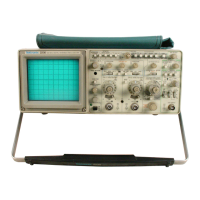Options
and
Accessories-2230 Operators
SRQ
Indicator-Indicates the communications option
requires service
by
the controller. Service requests are
cleared
when
the instrument has
been
polled for its
status
and
no
further warning or error conditions
are
pending.
The
communication option asserts a power-up
service request (SRO) when turned
on.
Other service
requests
are
asserted
as
enabled
by
the
ROS
and
OPC
commands.
ADDR
Indicator-Indicates
the instrument
is
addressed to
talk or listen.
PLOT Indicator-Indicates the communication option
is
currently sending waveform data over its interface
and
acquisitions
are
inhibited.
Instrument Response To Interface Messages
OPTION
10
GPIB.
The
following explain effects
on
the
oscilloscope of standard interface messages received from
a remote controller. Message abbreviations
used
are
from
ANSI/IEEE Std 488-1978.
LOCAL
LOCKOUT
(LLO)-Local
Lockout
is
not
supported
by
the instrument.
In
response to a LLO
message
via
the GPIB interface, Option 10 generates
an
SRO
error.
REMOTE
ENABLE
(REN)-When
Remote
Enable
is
asserted
and
the instrument receives its listen
address, the oscilloscope
is
placed
in
the Remote
State (REMS).
When
in
the Remote State, the
oscilloscope's Addressed (ADDR) indicator
is
lit.
Unasserting
REN
causes a transition to LOCS; the
instrument remains
in
LOCS
as
long
as
REN
is
false.
The
transition
may
occur after processing of a different mes-
sage
has
begun.
In
this case, execution of the message
being processed
is
not interrupted
by
the transition.
7-8
GO
TO
LOCAL
(GTL)-lnstruments that
are
already
listen-addressed respond to GTL
by
assuming a local
state. Remote-to-local transitions caused
by
GTL do
not affect the execution of
any
message
being
pro-
cessed
when
GTL was received.
MY
LISTEN
AND
MY
TALK
ADDRESSES
(MLA
AND
MTA)-The
primary Talk/Listen address
is
established
as
previously explained
in
the GPIB Parameter Selec-
tion information.
UNLISTEN
(UNL)
AND
UNTALK
(UNT)-When
the
UNL message
is
received, the oscilloscope's listen
function
is
placed
in
an
idle
(unaddressed) state.
In
the
idle
state, the instrument will not accept commands
over the
bus.
The
talk function
is
placed
in
an
idle state when the
oscilloscope receives the
UNT
message.
In
this state, the
instrument cannot transmit data
via
the interface bus.
INTERFACE
CLEAR
(IFC)-When
IFC
is
asserted,
both the Talk
and
Listen functions
are
placed
in
an
idle
state
and
the CRT
ADDR
indicator
is
turned off. This
produces the same effect
as
receiving both the UNL
and
the
UNT
messages.
DEVICE
CLEAR
(CCL)-
The DCL message reinitial-
izes communication between the instrument
and
the
controller.
In
response to
DCL,
the instrument clears
any
input
and
output messages
as
well
as
any unexe-
cuted control settings. Also cleared
are
any
errors and
events waiting to
be
reported (except the power-on
event). If the SRO
line
is
asserted for any reason
(other than power-on), it becomes unasserted when
the DCL message
is
received.
SELECTED DEVICE
CLEAR
(SOC)-
This message
performs the same function
as
DCL; however, only
instruments that have
been
listen-addressed respond
to
SDC.
SERIAL
POLL
ENABLE
AND
DISABLE
(SPE
AND
SPD)-
The Serial
Poll
Enable
(SPE)
message causes
the instrument to transmit its serial-poll status byte
when it
is
talk-addressed.
The
Serial
Poll
Disable
(SPD)
message switches the instrument back to its
normal operation.
Reset Under Communication Option Control
Some oscilloscope modes may
be
set to their default or
power-on states
by
sending the INlt command via the
communication option.
The
major settings that are
affected
by
INlt
are:
ACQUISITION REP:AVE
ACQUISITION HSREC:SAMPLE
ACQUISITION LSREC:PEAKDET
ACQUISITION SCAN:PEAKDET
ACQUISITION ROLL:PEAKDET
ACQUISITION SMOOTH:ON
ACQUISITION WEIGHT:4
(16
in
the 2220
and
2221)
ACQUISITION NUMSWEEPS:0
ACQUISITION VECTORS:ON
DATA ENCDG:BINARY
DATA SOURCE:ACQ
DATA TARGET:REF1
(REF4
in
the 2220
and
2221)
PLOT GRAT:OFF
PLOT FORMAT:<power-on setting>
READOUT
ON
Menu system reset.
--

